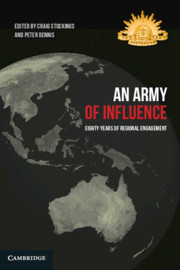Book contents
- An Army of Influence
- Acknowledgement of Country
- An Army of Influence
- Copyright page
- Foreword
- Contents
- Figures, maps and tables
- Contributors
- Abbreviations
- Introduction
- Part 1 The concept of an army’s influence abroad
- Chapter 1 Eighty years of regional engagement
- Chapter 2 The Australian Army through the lens of Australian defence white papers since 1976
- Chapter 3 Defence Attaché in Indonesia
- Part 2 Lessons from past relationships
- Part 3 Ongoing relationships
- Index
Chapter 1 - Eighty years of regional engagement
from Part 1 - The concept of an army’s influence abroad
Published online by Cambridge University Press: 16 November 2021
- An Army of Influence
- Acknowledgement of Country
- An Army of Influence
- Copyright page
- Foreword
- Contents
- Figures, maps and tables
- Contributors
- Abbreviations
- Introduction
- Part 1 The concept of an army’s influence abroad
- Chapter 1 Eighty years of regional engagement
- Chapter 2 The Australian Army through the lens of Australian defence white papers since 1976
- Chapter 3 Defence Attaché in Indonesia
- Part 2 Lessons from past relationships
- Part 3 Ongoing relationships
- Index
Summary
On 20 March 1939 the Burns Philp ship MV Macdhui docked at Port Moresby in the Australian territory of Papua. On board was the 13th Heavy Battery of the Royal Australian Artillery. Commanded by Major Kenneth Chalmers, the battery had been raised from permanent gunners in Sydney and had the task of installing and operating two 6-inch coast guns at Paga Point, Port Moresby. Less than four months earlier, on 6 December 1938, the Minister for Defence, Geoffrey Street, as part of a series of measures to strengthen Australian defences after the Munich crisis, had announced funding for the development of Port Moresby as ‘a base for mobile naval and air forces’.
- Type
- Chapter
- Information
- An Army of InfluenceEighty Years of Regional Engagement, pp. 20 - 37Publisher: Cambridge University PressPrint publication year: 2021

